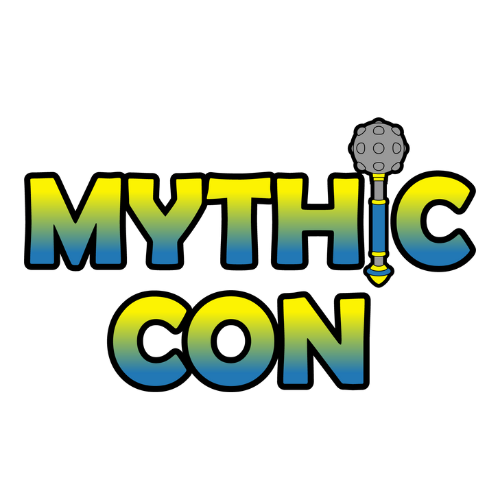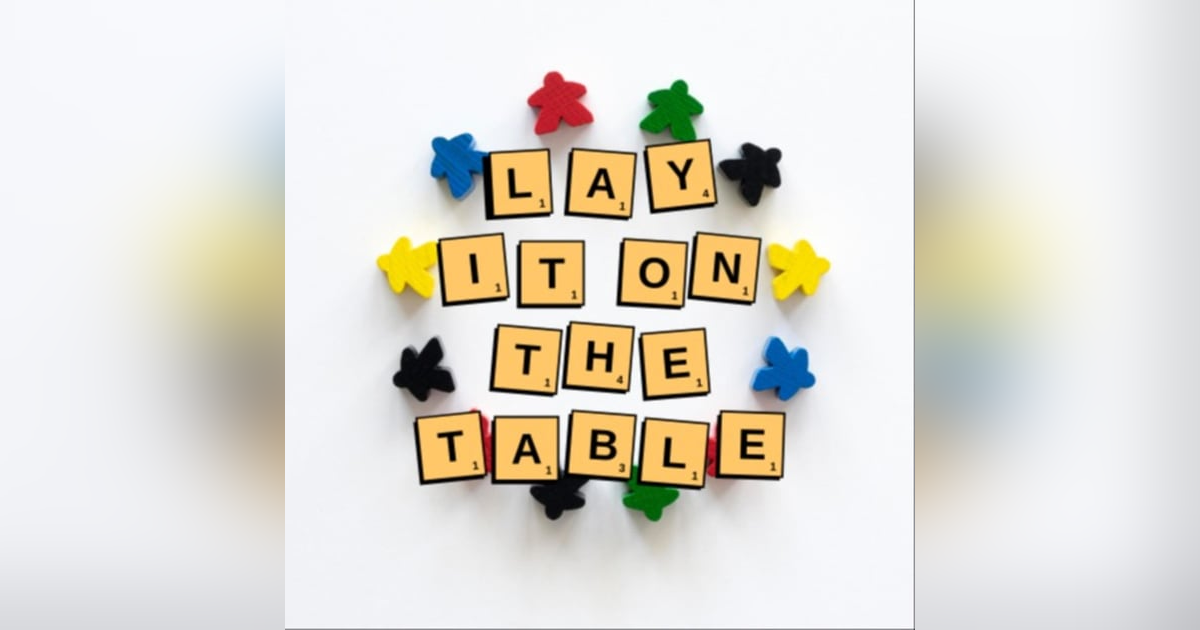Was ist Das Spiel?

In this episode of "Lay It On The Table," hosts Joe Mahaffey and James Engelhardt dive into the world of board games, discussing the latest releases and their experiences at Spiel Essen, the world's largest game event. They explore a variety of games, from light deck builders like "Bohemians" to heavier worker placement games such as "Covenant." The conversation also touches on the intricacies of games like "Cribbage" and "Edo," highlighting the unique mechanics and themes that make each game stand out. Additionally, they share personal anecdotes, including Joe's experience officiating a Halloween wedding and their plans for upcoming events like Mythicon.
Season 4, Episode 11
Was Ist Das Spiel?
News and Notes
Mythic Con
 https://tabletop.events/conventions/mythic-con-2025
https://tabletop.events/conventions/mythic-con-2025
News
 https://boardgamewire.com/index.php/2025/10/16/spiel-essen-eyes-record-220000-attendance-as-worlds-biggest-board-game-fair-expands-into-seventh-huge-hall/
https://boardgamewire.com/index.php/2025/10/16/spiel-essen-eyes-record-220000-attendance-as-worlds-biggest-board-game-fair-expands-into-seventh-huge-hall/
 https://www.spiel-essen.de/en/press?view=article&id=304&catid=12
https://www.spiel-essen.de/en/press?view=article&id=304&catid=12Games from Essen
 https://boardgamegeek.com/boardgame/437384/bohemians
https://boardgamegeek.com/boardgame/437384/bohemians/pic8978360.jpg)
 https://boardgamegeek.com/boardgame/429863/covenant
https://boardgamegeek.com/boardgame/429863/covenant/pic8968542.jpg)
 https://boardgamegeek.com/boardgame/446493/recall
https://boardgamegeek.com/boardgame/446493/recall/pic8886325.png)
 https://boardgamegeek.com/boardgame/429405/orloj-the-prague-astronomical-clock
https://boardgamegeek.com/boardgame/429405/orloj-the-prague-astronomical-clock:strip_icc()/pic8685899.png)
 https://boardgamegeek.com/boardgame/429438/ayar-children-of-the-sun
https://boardgamegeek.com/boardgame/429438/ayar-children-of-the-sun/pic8444642.jpg)
How to play what is on our tables
Joe
 https://boardgamegeek.com/boardgame/426912/tea-witches
https://boardgamegeek.com/boardgame/426912/tea-witches/pic8366420.png)
This year's Teaquinox Faire is heating up, and as a contestant, you have four days to prove to the world that your kettle has the mettle to win!
In Tea Witches, tea vendors from across the land must summon and serve lines of witches in order to gain their loyalty, all while sending out magical TeaPups to entice Celebri-Teas and find ways to further enhance their prestige. By growing their loyal fan base, upgrading their hut to maximize service, and collecting all the right tips and toppings they can prove that their tea reigns supreme.
The game lasts four rounds, each representing one day of the Teaquinox Faire. Each day has two phases. In the summoning phase, players simultaneously draw a crowd of witches to their tea hut, being mindful not to push their luck too far as any identical witches will cause a hex, which results in witches leaving the queue.
In the service phase, players take turns sending their adorable TeaPups to various Bootiques in the city to gather toppings and collect tea from the rotating crystal fountain in order to serve witches waiting at their hut. Additionally, TeaPups can help players collect powerful upgrades, attract Celebri-teas, and brew up Special-Teas with bonus abilities. Clever TeaPup placement can also help you complete to-go orders for witches out and about in the city center.
Completing tea orders, attracting celebrities, earning money, and upgrading your tea hut will earn players prestige, and at the end of the fourth day, the player with the most prestige will be declared the greatest tea witch of the Teaquinox Faire!
–description from the publisher
JAMES
 https://boardgamegeek.com/boardgame/2398/cribbage
https://boardgamegeek.com/boardgame/2398/cribbage/pic121093.jpg)
Cribbage is a card game invented in the early 17th century, based on the earlier game Noddy. It is played with a deck of standard playing cards and a signature piece of equipment called the cribbage board. Cribbage is traditionally played as a 2 player game.
In the version usually played today, each player is dealt a hand of 6 cards, from which they discard 2 into a special pile called the Crib. One card is then cut from the draw pile and turned face up - it is considered part of each player's hand and of the Crib. The players then play cards in turn, scoring points for hitting certain totals, or for making sets or sequences. Score is kept by moving pegs along tracks on the cribbage board. This is repeated until both players have exhausted their hand of cards.
Next, each player picks up their hand and determines all possible scoring combinations, pegging points again on the cribbage board. The dealer then picks up the Crib and scores it for all possible points. Then the cards are shuffled and the deal alternates. The winner is the first to reach 121 points.
 https://boardgamegeek.com/boardgame/113636/edo
https://boardgamegeek.com/boardgame/113636/edo:strip_icc()/pic7285666.jpg)
In Edo, players represent daimyo in mid-second millennium Japan who are trying to serve their shogun by using their samurai to construct castles, markets and houses in Tokyo and surrounding areas.
At the start of Edo – which won "best evening-length game" in the 2010 Hippodice Game Design competition under the name Altiplano – each player has five samurai tokens, seven houses, one market and three square action cards, each of which has four possible actions on it. One card, for example, allows a player to:
- Collect rice (up to four bundles depending on the number of samurai applied to the action),
- Collect $5 (per samurai),
- Collect wood (up to four, with one samurai on the action and one in the forest for each wood you want), or
- Build (up to two buildings, with two samurai on the card and one in the desired city, along with the required resources)
Each turn, the players simultaneously choose which actions they want to take with their three cards and in which order, programming those actions on their player cards, similar to the planning phase in Dirk Henn's Wallenstein and Shogun. Players then take actions in turn order, moving samurai on the board as needed (paying $1 per space moved) in order to complete actions (to the forest for wood, the rice fields for rice, cities to build, and so on). Before a player can move samurai, however, he must use an action to place them on the game board; some actions allow free movement, and others allow a player to recruit additional samurai beyond the initial five.
One other action allows you to recruit additional action cards from an array on the side of the game board, thereby giving you four (or more) cards from which to choose for the rest of the game.
Building in cities costs resources and gives you points as well as money; as more players build in a city, the funds are split among all present, with those first in the city receiving a larger share. Players can also receive points or buy stone by dealing with a traveling merchant.
Once at least one player has twelve points, the game finishes at the end of the round, with players scoring endgame bonuses for money in hand and other things. The player with the most points wins.
Edo includes separate game boards for 2-3 players and for 4 players.
 https://boardgamegeek.com/boardgame/13823/fairy-tale
https://boardgamegeek.com/boardgame/13823/fairy-tale/pic2024738.jpg)
Players use card drafting and simultaneous action selection to score points while interfering with other players' ability to do so. The game consists of four rounds. In each of them, players are dealt five cards. They simultaneously select one each and pass the remainder, repeating until done. Then, they start playing cards simultaneously, playing three and discarding two. When the cards are revealed after each selection, card abilities turn other cards face-up or face-down. At the end of the four rounds there are 12 cards in front of each player. The players each score based on their face-up cards.
New to the Collection
Joe
James
Kickstarter
Joe



James
 https://boardgamegeek.com/boardgame/343433/tir-na-nog
https://boardgamegeek.com/boardgame/343433/tir-na-nog/pic8402314.png)


















